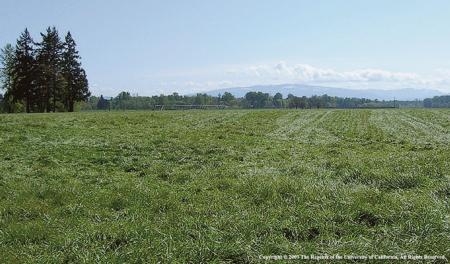Posts Tagged: agritourism
Agritourism an option in the San Joaquin Valley
Even though the typical San Joaquin Valley farm is focused exclusively on food production, local growers can profit from increasing interest in agritourism, reported Helen Tracey-Noren in the Fresno Bee. The concept was touted at a recent forum in Fresno where CDFA secretary Karen Ross and the CEO of Visit California, Caroline Beteta, spoke about the agritourism trend.
"It's about, 'here's what farmers and ranchers are doing as your neighbors,' their environmental stewardship," said Ross. "It's about the pride of what we produce here, and it's about this wonderful lifestyle and supporting the economy at the same time."
Penny Leff, the agritourism coordinator with the UC small farm program, also participated in the event. She said that from 2007 to 2012, agritourism has picked up in California.
"Most families don't have anyone on the farm anymore to go visit," Leff said. "Farmers are interested in educating the public in what's going on, what goes into making the food. They really want to share with the public and make them understand."
The story gave the example of Debbie and Jim Van Haun, a Sanger couple who opened Sequoia View Bed and Breakfast about 15 years ago, and fixed up an adjoining vineyard in 2003. They said that during the summer season, the area could use more businesses to handle all the tourists.
Agritourism and Nature Tourism in California - Second Edition
By Holly George and Ellie Rilla
151 pages, $25

Offering dinner in a winery barn is a form of agritourism.
Creativity helps small-scale farmers survive
To survive as a small-scale farmer, it may not be enough to merely grow food. With most people eating food grown by very large commercial agricultural enterprises, small farmers can attract sales with some creativity and a personal touch, reported Gosia Wozniacka of the Associated Press.
Farm operators generated $10 billion in 2007 from farm-related activities other than crop or livestock wholesale, an increase of nearly 80 percent from 2002, the article said.
For perspective on what is known as value-added agriculture, Wozniacka spoke to Shermain Hardesty, UC Cooperative Extension specialist in the Department of Agricultural and Resource Economics at UC Davis. Hardesty said value-added products are "a way to have a product to sell year-round, even during winter months."
Examples of value-added products are jams and jellies, farm stays, workshops and U-pick operations.
"It reinforces farmers' connection to consumers," Hardesty said. "And by getting involved in marketing their identities, they can expand their profitability."

Providing the public a 'farm experience' can help small-scale farmers stay afloat.
Forget five-star hotels, book a farm
Sunset Magazine ran an article this month encouraging readers to consider a farm stay for their next vacation. Beside a tranquil and scenic break from the office, farm visits help small-scale farmers sustain their operations, the article said.
“Farmers are recognizing that people are willing to pay for this experience,” said Penny Leff, agritourism coordinator for the University of California small farm program, whose researchers have seen a boost in the number of farms catering to visitors in recent years.
The small farm program maintains an online list of farms at http://calagtour.org that offer a wide range of agritourism opportunities to the public, from farm stays to U-pick operations, petting zoos, corn mazes, hay rides and farm stores.
The Sunset article details what it calls the "Top 8 Agritourism Experiences," including cattle herding, chicken butchery, wine making and goat cheese making.

Opening a ranch for hiking and birdwatching is another form of agritourism.
Riverside supervisors to include UC Riverside on new ag trail map
The Riverside County Board of Supervisors approved development of a local "Ag Trail" to promote California's 12th largest agricultural industry, according to a report in Valley News.
The online and printed Ag Trail map will locate many of the county's 1,700 dairies, farms, ranches, wineries, farmers markets, historical and cultural points of interest and UC Riverside agricultural research facilities.
"The idea is to promote agriculture, to promote the purchase of our products," said Tom Freeman, spokesman for the county Economic Development Agency. "We would target international visitors, domestic guests and our own residents."
Officials are aiming to complete the map by February 2013.
UCCE plans meeting to help producers with new water rules
Farmers and ranchers who use river or stream water must start submitting precise monthly records to the California Water Quality Control Board this year, said an article by Tim Hearden in Capital Press.
Before the new law took effect, the water board asked landowners for estimates, said Allan Fulton, a University of California Cooperative Extension advisor who serves Colusa, Glenn and Shasta counties. Fulton is an irrigation and water resources expert.
"There is a statewide effort at trying to more precisely understand and quantify how water is being used," he said.
UC Cooperative Extension will host a workshop March 31 to discuss the new requirement.
"I've had enough questions that I thought we ought to organize something," said Larry Forero, a UCCE director and advisor in Trinity County who specializes in livestock and natural resources.
Agritourism generates income, promotes farms
Tim Hearden, Capital Press
Agritourism, or activities and products offered on working farms to generate extra income from visitors, is a growing movement in California.
A recent UC survey determined that about 2.4 million visitors came to California farms in 2008 to enjoy some facet of agritourism, which could include lodges and cabins, pumpkin patches, corn mazes, "U-pick" operations and special events such as weddings and conferences.
"I think it really does help" farms, said UC agritourism coordinator Penny Leff. "It helps their name recognition if they're selling at the farmers' market or local stores. It helps in general for people to understand what farming's about, that food comes from farms."



